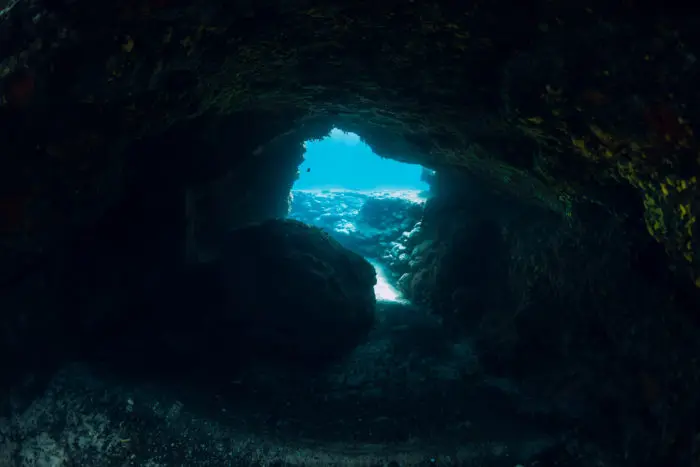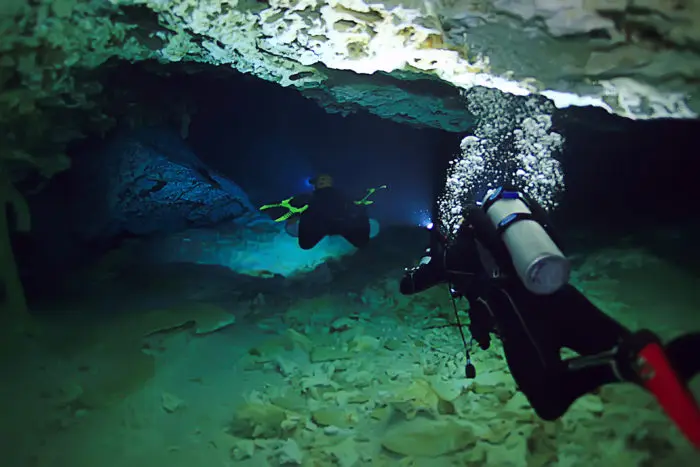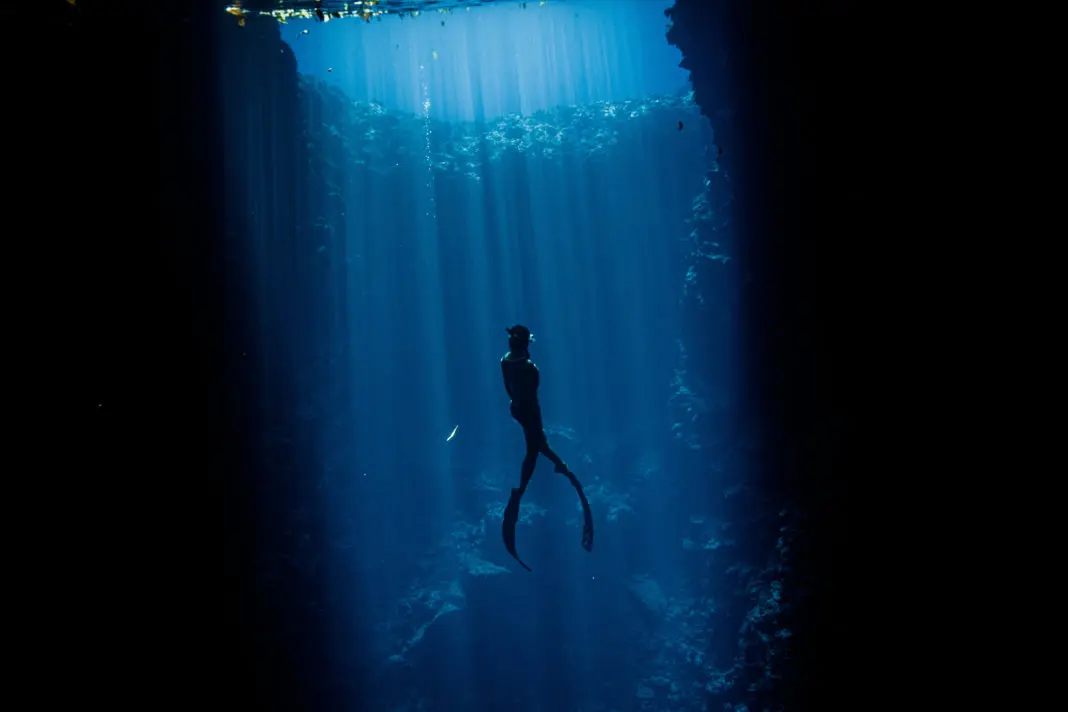Freediving can feel very much like exploring at times. We descend to places in the ocean that are not visible from the surface and often meet creatures easily since we are not blowing scuba bubbles and scaring them away. This love of exploration may lead some freedivers to want to explore caves as well, but caves are more dangerous than freedivers may think.
There are multiple risk factors involved in cave diving, and even the most experienced freedivers may think that they can handle them. However, the truth is that caves are wildly unpredictable. This post is not aimed at educating freedivers on how to freedive in caves safely, but rather to inform freedivers of the risks that they are taking when choosing to dive in them; read on to discover these risks in detail.
Overhead Environment
Freedivers should avoid overhead environments at all costs when freediving. As freedivers, we rely only on our breath-hold and self-awareness to recognize our limits and ascend when necessary. There are many risks when freediving other than shallow water blackouts: loss of a mask, loss of a fin, equalization problems, panic, entanglement, stings from marine life, cuts, or scrapes against rock and coral, etc.
If a freediver encounters any one of these problems, it is pure instinct to ascend directly to the surface, breathe, and deal with the issue. If a freediver is diving in an overhead environment, their breath-hold time must be extended and they must be entirely focused in order to find the exit and reach the surface. Any of these risks become much more dangerous if you cannot make an unplanned return immediately to the surface.
The Buddy System Becomes Ineffective
The one-up, one-down buddy system while freediving is important for a reason. A buddy must be able to see the freediver at all times or feel the dive line to detect any signs of trouble. In an overhead environment such as a cave, the buddy will not be able to see the freediver for a part of the dive, which becomes much the same as freediving alone (remember that the most important rule in freediving is to never dive alone).
Cramped Passages

Cramped openings, passages, or exits are something that should never be an option for freedivers. Our time is limited when we dive, and if there is any chance of getting trapped or scraping against rock or coral, this could significantly raise a freediver’s heart rate or cause panic, making ascending in time much less of a possibility.
Unpredictable Water Conditions
Water conditions can be unpredictable, and being inside of a cave is no exception and offers no protection. Waves, currents, tides, thermoclines, and visibility affect dives, and unforeseen circumstances can occur in the middle of a dive. It is possible for a freediver to exit a shallow cave and have a wave knock them into the edge of the cave, or to accidentally stir up sand while diving and severely affect the visibility around the freediver, thereby causing disorientation. Diving against currents can use up a lot of a freediver’s energy and greatly impact oxygen consumption, along with the shock that accompanies encountering a thermocline.
Exits Can Appear Closer
Wearing a mask underwater produces optical distortion, which affects how a diver sees an object’s size and distance. Even if an exit can appear to be nearby, it can actually be further away. This becomes hazardous if you are nearing the end of your oxygen supply or if you have encountered a problem and have to make a quick or unplanned exit.
Bad Air Pockets

In a cave, air pockets may seem tempting to take a break and take a breath. This is an absolutely inadvisable decision to take as a freediver. Air trapped in caves can easily be bad air, which can cause impairing physical symptoms, blood acidosis, and death in extreme cases. Bad air is usually created by an increase of carbon dioxide and/or a decrease of oxygen, and the effects of bad air can worsen depending on the air pressure in the cave. Even if the air is only slightly contaminated, there is no way for freedivers to measure it, which means they do not know how much usable oxygen they will have inhaled and how long they can dive on that air.
Lung overexpansion can also become an issue if a freediver is at depth and takes a full breath, which is why freedivers do not take air from scuba divers. As a freediver ascends from depth, the ambient pressure decreases and causes their lungs to expand. If their lungs are already fully inflated with air, the lungs will become overexpanded, which can cause an arterial gas embolism, pneumothorax, or subcutaneous emphysema.
Equipment Malfunction
Caves can be quite dark, which means that freedivers would require a flashlight. If a flashlight malfunction in the middle of a dive and the diver is not carrying a back-up, the situation can quickly take a dangerous turn. Even if the freediver does have a back-up, it takes extra time and focus to locate the flashlight and turn it on, which can cause a spike in heart rate and possible panic. Introducing more equipment into freediving increases the risk of equipment malfunction/failure; diving in locations that do not require extra equipment is always safer and gives freedivers more peace of mind.
Final Thoughts
Often, freedivers of every level make the mistake of thinking they are invincible. They may recognize the risks they take and still engage in the behavior, or they may not know the risks at all and make costly mistakes. It is important to recognize that freediving is still considered an extreme sport, and is only safe when practiced correctly. Freediving in caves creates multiple risk factors, and it is important for every diver to be informed of these risks should they choose to dive anyways. Even the most experienced freedivers can still become helpless when faced with an unexpected situation.
Do you have any other risks that are associated with freediving in caves? Let us know in the comment section below.

